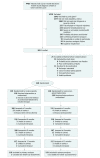Effect of Opioid vs Nonopioid Medications on Pain-Related Function in Patients With Chronic Back Pain or Hip or Knee Osteoarthritis Pain: The SPACE Randomized Clinical Trial
- PMID: 29509867
- PMCID: PMC5885909
- DOI: 10.1001/jama.2018.0899
Effect of Opioid vs Nonopioid Medications on Pain-Related Function in Patients With Chronic Back Pain or Hip or Knee Osteoarthritis Pain: The SPACE Randomized Clinical Trial
Abstract
Importance: Limited evidence is available regarding long-term outcomes of opioids compared with nonopioid medications for chronic pain.
Objective: To compare opioid vs nonopioid medications over 12 months on pain-related function, pain intensity, and adverse effects.
Design, setting, and participants: Pragmatic, 12-month, randomized trial with masked outcome assessment. Patients were recruited from Veterans Affairs primary care clinics from June 2013 through December 2015; follow-up was completed December 2016. Eligible patients had moderate to severe chronic back pain or hip or knee osteoarthritis pain despite analgesic use. Of 265 patients enrolled, 25 withdrew prior to randomization and 240 were randomized.
Interventions: Both interventions (opioid and nonopioid medication therapy) followed a treat-to-target strategy aiming for improved pain and function. Each intervention had its own prescribing strategy that included multiple medication options in 3 steps. In the opioid group, the first step was immediate-release morphine, oxycodone, or hydrocodone/acetaminophen. For the nonopioid group, the first step was acetaminophen (paracetamol) or a nonsteroidal anti-inflammatory drug. Medications were changed, added, or adjusted within the assigned treatment group according to individual patient response.
Main outcomes and measures: The primary outcome was pain-related function (Brief Pain Inventory [BPI] interference scale) over 12 months and the main secondary outcome was pain intensity (BPI severity scale). For both BPI scales (range, 0-10; higher scores = worse function or pain intensity), a 1-point improvement was clinically important. The primary adverse outcome was medication-related symptoms (patient-reported checklist; range, 0-19).
Results: Among 240 randomized patients (mean age, 58.3 years; women, 32 [13.0%]), 234 (97.5%) completed the trial. Groups did not significantly differ on pain-related function over 12 months (overall P = .58); mean 12-month BPI interference was 3.4 for the opioid group and 3.3 for the nonopioid group (difference, 0.1 [95% CI, -0.5 to 0.7]). Pain intensity was significantly better in the nonopioid group over 12 months (overall P = .03); mean 12-month BPI severity was 4.0 for the opioid group and 3.5 for the nonopioid group (difference, 0.5 [95% CI, 0.0 to 1.0]). Adverse medication-related symptoms were significantly more common in the opioid group over 12 months (overall P = .03); mean medication-related symptoms at 12 months were 1.8 in the opioid group and 0.9 in the nonopioid group (difference, 0.9 [95% CI, 0.3 to 1.5]).
Conclusions and relevance: Treatment with opioids was not superior to treatment with nonopioid medications for improving pain-related function over 12 months. Results do not support initiation of opioid therapy for moderate to severe chronic back pain or hip or knee osteoarthritis pain.
Trial registration: clinicaltrials.gov Identifier: NCT01583985.
Conflict of interest statement
Figures
Comment in
-
Nonopioids and opioids gave similar relief for back pain or osteoarthritis but nonopioids had fewer adverse effects.Ann Intern Med. 2018 Jun 19;168(12):JC64. doi: 10.7326/ACPJC-2018-168-12-064. Ann Intern Med. 2018. PMID: 29913489 No abstract available.
-
Opioids vs Nonopioids for Chronic Back, Hip, or Knee Pain.JAMA. 2018 Aug 7;320(5):508. doi: 10.1001/jama.2018.6937. JAMA. 2018. PMID: 30088001 No abstract available.
-
Opioids vs Nonopioids for Chronic Back, Hip, or Knee Pain.JAMA. 2018 Aug 7;320(5):507-508. doi: 10.1001/jama.2018.6941. JAMA. 2018. PMID: 30088002 No abstract available.
-
Opioids vs Nonopioids for Chronic Back, Hip, or Knee Pain.JAMA. 2018 Aug 7;320(5):506-507. doi: 10.1001/jama.2018.6945. JAMA. 2018. PMID: 30088003 No abstract available.
-
Opioids vs Nonopioids for Chronic Back, Hip, or Knee Pain.JAMA. 2018 Aug 7;320(5):507. doi: 10.1001/jama.2018.6949. JAMA. 2018. PMID: 30088004 No abstract available.
-
Chronischer Schmerz: Opioide ohne Vorteil.MMW Fortschr Med. 2018 Oct;160(18):38. doi: 10.1007/s15006-018-1022-y. MMW Fortschr Med. 2018. PMID: 30350070 Review. German. No abstract available.
-
Uncritical Publication of a Biased Study Leads to Misleading Media Reports.Pain Med. 2019 Jul 1;20(7):1274-1276. doi: 10.1093/pm/pny234. Pain Med. 2019. PMID: 30462306 No abstract available.
-
Opioids Are Not Better than Non-opioid Pain Medications for Chronic Back, Hip, or Knee Pain.J Gen Intern Med. 2019 Sep;34(9):1854-1856. doi: 10.1007/s11606-019-05016-4. J Gen Intern Med. 2019. PMID: 31342325 Free PMC article. No abstract available.
References
-
- Reuben DB, Alvanzo AA, Ashikaga T, et al. . National Institutes of Health Pathways to Prevention Workshop: the role of opioids in the treatment of chronic pain. Ann Intern Med. 2015;162(4):295-300. - PubMed
-
- Department of Veterans Affairs/Department of Defense Management of opioid therapy for chronic pain. https://www.healthquality.va.gov/guidelines/Pain/cot/VADoDOTCPG022717.pdf. Accessed February 7, 2018.
-
- Dowell D, Haegerich TM, Chou R. CDC guideline for prescribing opioids for chronic pain—United States, 2016. MMWR Recomm Rep. 2016;65(1):1-49. - PubMed
-
- Chou R, Turner JA, Devine EB, et al. . The effectiveness and risks of long-term opioid therapy for chronic pain: a systematic review for a National Institutes of Health Pathways to Prevention Workshop. Ann Intern Med. 2015;162(4):276-286. - PubMed
Publication types
MeSH terms
Substances
Associated data
Grants and funding
LinkOut - more resources
Full Text Sources
Other Literature Sources
Medical


